It is noteworthy that more than one method of marking an animal can be used. Thus, hot iron branding can be combined with coloured, numbered ear tags. Prior to marking, the side on which the relevant marks will be applied must be decided with care. If a farmer likes to work on the right side of animals and his cattle handling race is designed to work from the right-hand side, marking of animals must be done on the same side.
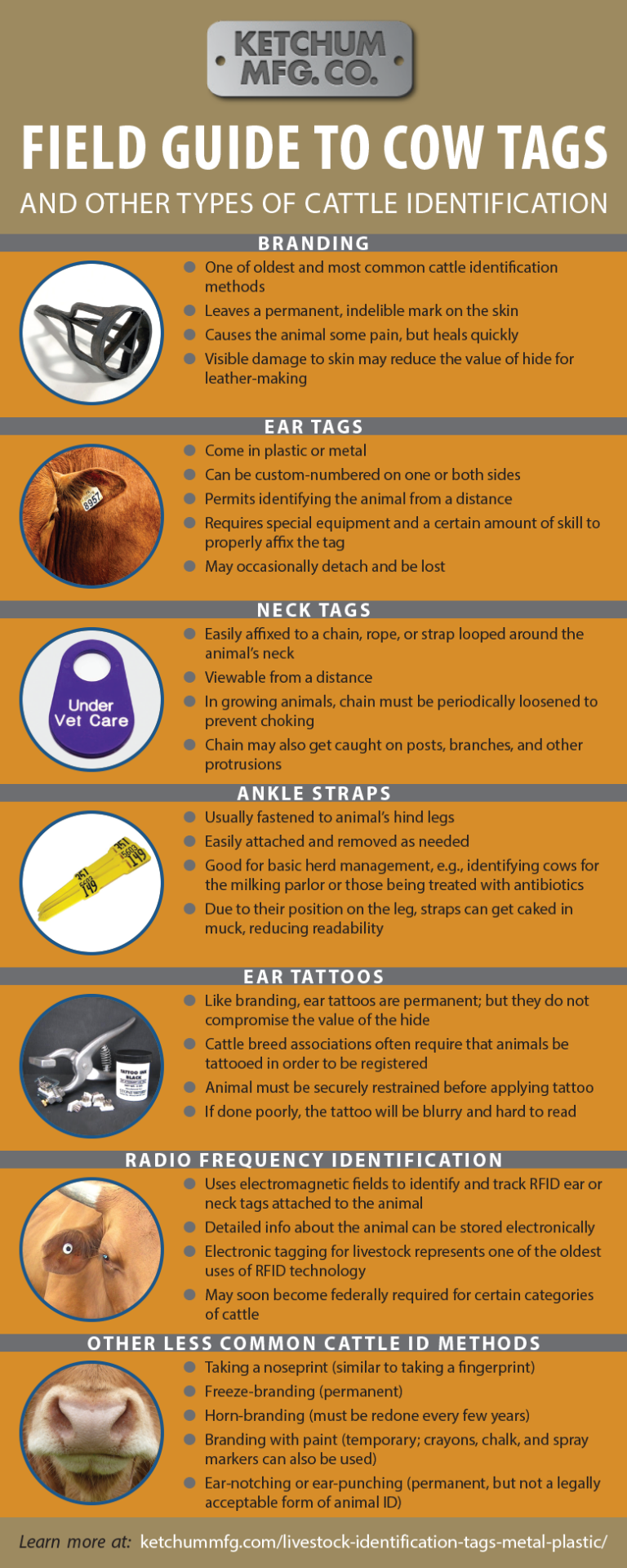
Click here to view a video that explains livestock and poultry official identification.
Branding
Branding is a time-consuming task and, unless theft is a problem, should be confined to animals that are likely to remain in a herd or to stud animals where branding is compulsory. In many parts of South Africa, branding is or will become compulsory by law. The registration of brands with the Registrar of Livestock Improvement is essential to ensure that owners of livestock have a unique right to their own identifying brands.
Whether hot iron branding, freeze branding or chemical cautery (a practice not common in South Africa, which will therefore not be discussed) is used, branding comprises cauterisation of the skin, killing the hair follicles and leaving a scar. Over-cauterisation e.g. holding a hot iron against the skin for too long a time causes the whole skin area around the brand to be damaged, resulting in a smudged brand. This is often the case when a branding iron is too heavy (the iron from which the brand is made is thick and radiates a lot of heat). On the other hand, a branding iron must not be too sharp where it comes in contact with the animal, this can cause open wounds which could lead to infections and blow flystrike, resulting in illegible brands.
Coat colour and the relevant animal’s associated skin colour affect the legibility of a brand. Thus a brand on a dark-skinned animal with light hair colour is often very legible because the resulting scar shows up dark against the light hair or the hair growing on the scar is darker.
An important consideration is that branding irons should be designed in such a way that there are no letters enclosing a whole area of skin e.g. an O should not be a complete circle but should have at least one, preferably two openings on the O, thus. This consideration holds for the letters A, B, D, O, P, Q (should preferably not be used), and R.
Damage to hides is a problem with all types of branding. It is often advised that brands are placed on the neck area or just above the hock or elbow joint. These are difficult sites to brand because animals tend to jump around when branded. A brand on the rump just behind the hip bone, although it damages the hide, is easier to apply and is easily read, especially when animals stand in a tight group. Branding sites where the skin tends to be mobile or folds when an animal moves, cause discomfort to the animal during the healing period.
There is a tendency to use very large brands involving many digits. Apart from damage to hides and discomfort to animals, a great deal of time is wasted applying large brands. Joining digits on the same branding iron is used to try and limit the problem. However, applying a brand with a branding iron of more than two digits is difficult and often unsuccessful.
Hot-Iron Branding
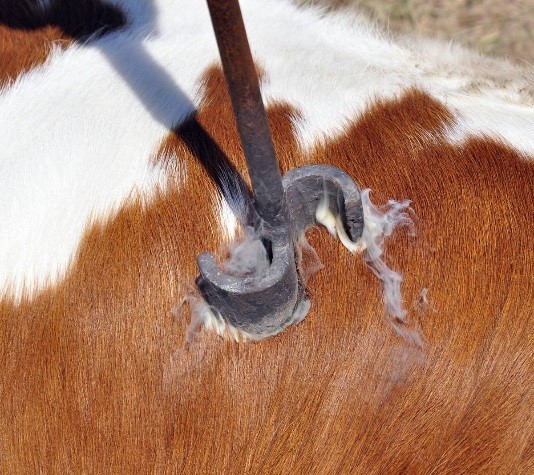
Good hot iron brands are permanent and legible from a distance. Poor branding procedures that cause smudging and brands on animals with woolly coats could render hot iron brands less acceptable.
When applying hot iron brands, animals must be dry and the area where the brand is applied must be relatively clean. Moisture or mud on the hair leads to smudged and poor brands. Where the coat is relatively heavy or woolly, the hair can catch alight, leading to smudged brands.
Branding irons must be heated to a dull glow. If uncertain if the irons are hot enough, the heat can be tested on a wooden plank. The animal must be restrained and held very still when the brand is applied. The length of time the brand is applied varies from 3 to 5 seconds, depending on how hot the iron is and the amount of pressure applied. The branding iron must be held firmly because the steam produced often causes the branding iron to slip. With practice, the right amount of heat applied long enough without slipping is usually achieved. If the hair on the branding site is the colour of brown shoe polish and the skin is not broken, the brand has been applied correctly.
After branding, it is best not to apply any medication. Clean water could be applied to cool off the brand area quickly and, if a blowfly strike is a problem, a fly repellent is used. Should any medication be applied, it must be selected with care because an area with skin damage is prone to absorbing chemical substances rapidly, which could cause problems if toxins are involved.
Click here to view a video that explains tips for cattle branding.
Freeze Branding
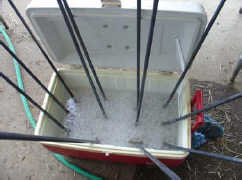
Freeze branding is considered more humane than hot iron branding but is not always as successful as hot iron branding and requires more equipment and time to apply. Keeping animals still during the application of the brand is essential.
The hair is clipped as short as possible over the area where the brand is to be applied. The branding irons, which are of a much more robust design than hot iron brands, are cooled off in liquid nitrogen or dry ice (solid carbon dioxide) with methylated spirit. The amount of time the branding iron is applied to the skin varies from 28 to 60 seconds. At the shorter time interval, there is de-pigmentation of the hair follicles and at the longer time interval, the hair follicles are destroyed.
The hair and related skin colour, therefore, has a major effect on the application of freeze branding. Thus, applying the branding iron for a short duration to cause de-pigmentation of white hairs on white skin will result in no visible brand, whereas de-pigmentation of black hair on white skin is very successful.
Click here to view a video that explains cattle freeze branding.
Tattooing
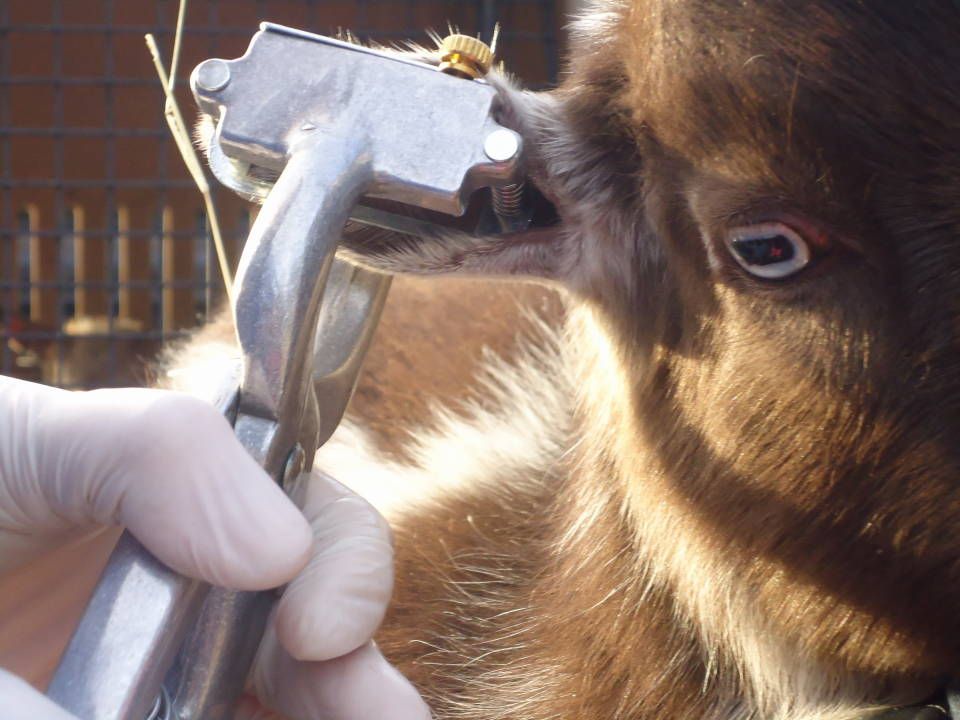 |
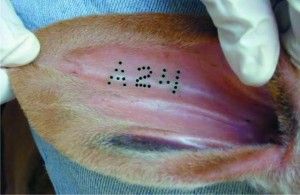 |
Tattoos are made using spiked letters placed in a plier-like instrument. The area where the tattoo is to be applied, usually the ear or an area where a fold of skin can be lifted, is cleaned and pierced. Tattoo paste, liquid or black stove polish is rubbed vigorously into the holes.
Tattoos are very good permanent markers if applied by an experienced person. A black tattoo is however not visible on black skin. The other problem with tattoos is that an animal must be constrained, and the tattoo area cleaned before the mark can be read.
Click here to view a video that explains the tattoo identification of beef cattle.
Plastic Tags
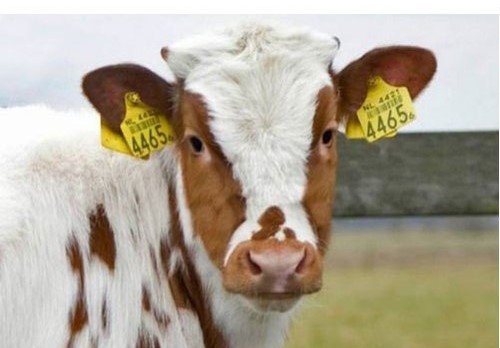
Plastic tags are very commonly used and are legible from a short distance. The problems with plastic tags are that they tend to fall out, lettering can become illegible and dirt can obscure letters. They are often useful when used in conjunction with more permanent markings, such as brands or tattoos, but usually require regular replacement.
Various plastic tags with their associated applicators are available on the market. The best place to apply a plastic tag is between the lower and middle cartilaginous ridge of the ear (there are three horizontal ridges on the inside of the ear of cattle), halfway between the attachment of the ear to the head and the outer edge of the ear.
The surfaces of plastic tags contain chemicals that react with the correct pen to produce lettering. If the incorrect pen is used, or a batch of tags is old or badly scuffed, lettering is apt to disappear rapidly. Furthermore, once lettering on plastic tags become illegible, it is best to replace it with a fresh tag rather than to try and write over the faded letters.
Pre-marked tags are available on the market but cost more and these letters are also apt to fade or peel off.
Metal Tags
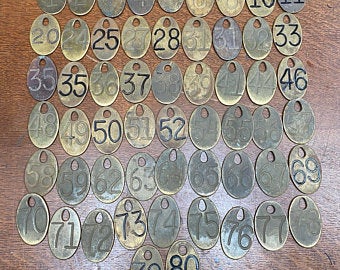
Self-locking metal tags are reliable and easily applied with the special applicator. They can usually only be read from close up and are less prone than plastic tags to be ripped out.
When applying the metal tags, care must be taken to ensure that the sharp point on the one side of the tag locks firmly into the two holes on the opposite side of the tag. Metal tags are applied to the outer edge of the ear, relatively close to the head of the animal and space must be left so that the ear can grow and must not be closed too tightly. Where metal tags are too tight, ticks tend to collect under the tag, causing abscesses.
Click here to view a video that explains how to ear tag sheep and goats.
Ear Notching
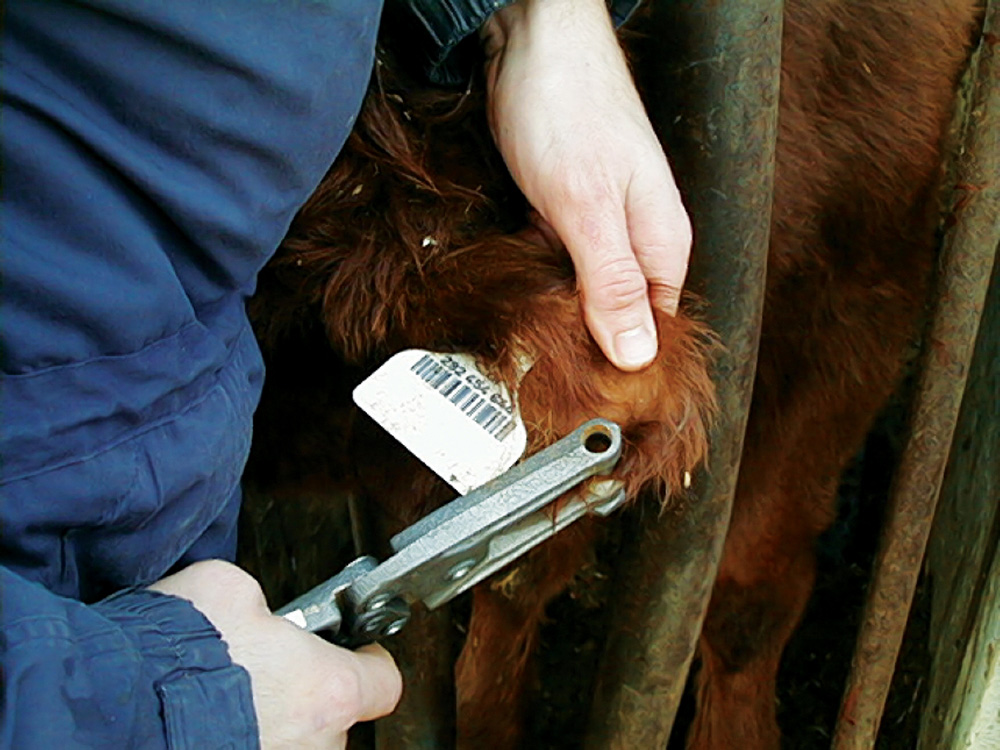
Ear notching is a permanent means of animal numbering that can be used in many ways but is disliked by many farmers because ears tend to tear, making the reading of notches difficult and the disfigurement caused to animals. Although herders rapidly learn to read notches, misreading of notches is common, especially when the hair on the ears is long. Numbers are notched. Notching can be used in other ways, for example, if branding is the identification method of choice, a cow that skips a breeding season is marked with a notch on the tip of an ear.
Click here to view a video that explains how to read ear notches.
Electronic Markers
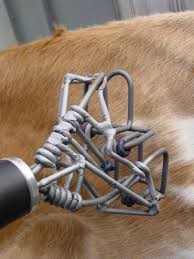
Electronic markers are available whereby a small micro-chip is implanted at a convenient site e.g. next to the trailhead or in the thick neck muscles. An instrument that must be pointed at the implant site from a relatively short distance is used to read the signalled identity number of the animal emanating from the microchip. Where this system is available it is very useful, but microchips can become faulty.
Click here to view a video that explains how to apply identification ear tags.
DNA Finger Printing
With modern technology, the genetic makeup of an animal can be recorded as an electrophoretic image. In cattle, these images are unique and can be used to identify animals by sending a sample of blood or other appropriate tissue to a laboratory with the required equipment. Although not a technique that can be used for routine identification, it can be used for example where an animal is slaughtered and the thieves leave the animal’s skin behind, taking only some or all of the meat. With DNA fingerprinting the relevant meat can be identified as belonging to the skin and its identifying brand.

System for numbering livestock using ear notching and holes.